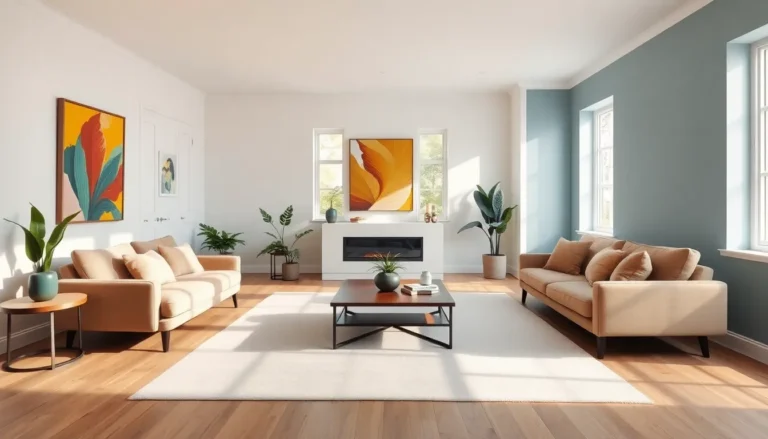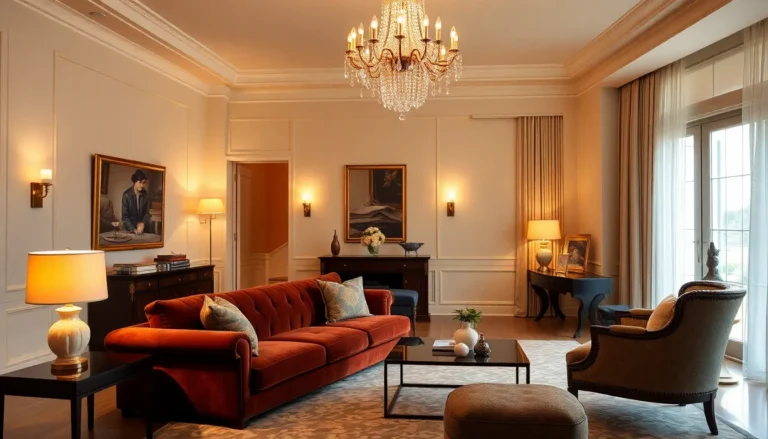Imagine walking into a space that instantly wraps you in warmth, like a favorite childhood blanket on a chilly evening. Farmhouse living rooms are just that, a delightful mix of rustic charm and contemporary flair. They beckon homeowners to forge connections with nature while enjoying the comfort of modern conveniences. This cozy approach isn’t just a trend: it’s a lifestyle embracing simplicity and warmth. If you’re ready to transform your living space into a cozy retreat that feels like home, let’s jump into the essential elements of farmhouse living rooms and see how they can elevate your home into a stylish haven.
Table of Contents
ToggleElements of Farmhouse Design

At the heart of farmhouse design lies an unmistakable warmth that invites you in. This aesthetic thrives on an open and airy feel, often accentuated by high ceilings and large windows that flood the space with natural light. Natural materials play a starring role here. From reclaimed wood beams to exposed brick, these elements bring in the outdoors while adding character.
Textiles also contribute significantly. Soft linens, wool throws, and burlap accents elevate comfort and add texture to the living room. They not only look good but also provide warmth, making the space feel lived-in and inviting. Another important element is rustic furniture, which often features vintage or distressed finishes. Each piece tells a story, enhancing the charm of the entire room. Whether it’s a weathered coffee table or a cozy armchair, the furniture selection is essential in crafting that welcoming farmhouse vibe.
Color Palettes for Farmhouse Living Rooms
When it comes to color, think soft and soothing, like a picturesque countryside sunset. Typical farmhouse palettes often revolve around neutral tones: whites, creams, soft grays, and earthy browns. These colors serve as a calming backdrop, allowing the beauty of natural materials to shine.
Accent colors can refresh the look without overwhelming it. Soft pastels or muted shades of blue, green, and even terracotta can add just the right pop. Accent walls painted in these hues can create an inviting focal point without straying from the overall rustic elegance.
To really embrace the farmhouse style, consider using paint techniques like shiplap or even wallpaper with subtle patterns. These layers of color and texture enrich the living space, making it one that tells its own story.
Furniture Choices for Comfort and Style
Selecting furniture for a farmhouse living room is an art form. Look for pieces made from natural materials, such as hardwood or wicker, which harmonize beautifully with the design ethos. Comfort is key, so oversized sofas and plush armchairs should take precedence. Imagine sinking into a soft seat with your favorite book, pure bliss.
Multifunctional furniture is also a staple. A vintage trunk can double as a coffee table and provide extra storage. Likewise, nesting tables can be rearranged to suit gatherings of any size, making them practical and stylish.
Don’t shy away from mixing styles: a chic modern sofa can coexist with antique armchairs, creating a collected-over-time look. This diversity in furniture not only enhances visual interest but also showcases personal taste.
Incorporating Decorative Accessories
Accessories are where the farmhouse living room truly comes to life. Consider lovely touches with handmade items, like pottery or woven baskets that evoke a sense of craftsmanship. They tell a story and prompt conversation, which is exactly what a cozy living space should do.
To soften the aesthetics further, textiles like throw pillows and blankets can be used to add layers and warmth. Patterns like plaid or floral work wonderfully in a farmhouse setting. Place these on sofas or chairs to accentuate comfort.
Another great idea is displaying artwork or family photos in rustic frames. Gallery walls can be a fantastic way to showcase life’s moments and sentimental treasures, turning the living room into a repository of memories as much as design.
Creating a Functional Layout
When designing a farmhouse living room, functionality should not play second fiddle to aesthetics. The layout is crucial in promoting conversation and comfort. Placing furniture in conversational groups creates an inviting atmosphere. Think about arranging your sofa and chairs in a U-shape where guests can easily engage with each other.
Leave enough space for traffic flow: after all, a living room should accommodate both relaxation and movement. Positioning a coffee table in the center facilitates game nights or coffee chats without cramping anyone’s style.
Use corners creatively. Corner bookshelves or plants can fill empty spaces while adding personality. This thoughtful approach ensures the room feels spacious and well-organized, eventually reflecting the farmhouse ethos of welcoming simplicity.
Seasonal Decor for Farmhouse Living Rooms
Embrace the changing seasons by rotating your decor to keep the living room feeling fresh and inviting. In spring, pastel colors and floral arrangements breathe life into the space. Summer calls for breezy fabrics and lighter textures to make the room airy.
As autumn approaches, consider swapping in warm hues, pumpkins, and cozy throws to envelop the room in comfort. Winter is prime for deeper colors, twinkling lights, and festive decor to create a snug ambiance.
This regular transformation keeps the living room lively, ensuring it consistently reflects the beauty of each season. You’d be surprised how simple swaps, like changing out a throw blanket or switching up accent pillows, can make such a dramatic difference.




